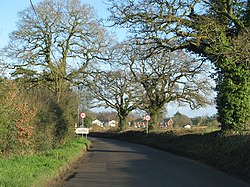Feniton
| Feniton | |
| Devon | |
|---|---|
 Approaching Feniton | |
| Location | |
| Grid reference: | SY096993 |
| Location: | 50°47’12"N, 3°16’57"W |
| Data | |
| Population: | 1,568 (2011) |
| Post town: | Honiton |
| Postcode: | EX14 |
| Dialling code: | 01404 |
| Local Government | |
| Council: | East Devon |
| Parliamentary constituency: |
Tiverton and Honiton |
Feniton is a village in eastern Devon, about four miles west of Honiton and three miles north of Ottery St Mary.
There are in fact two separated villages, both under the one name: the old village where the church and original village centre are found and a new village three quarers of a mile west of the original village and is separated by open countryside. This latter area developed around the railway station and was formerly known as 'Sidmouth Junction'.
The wider civil parish of Feniton incorporates also the hamlets of Colesworthy, Higher Cheriton and Curscombe. At the 2011 census the parish had a population of 1,568.
Parish church
The original village of Feniton contains the 13th-century Church of St Andrew,[1]
History
The village in itself is ancient, but the new village is an invention of modernity.
The new village, three quarters of a mile west of the old, is in origin a station village, growing up around what was called Sidmouth Junction Station, and this new hamlet was originally known as 'Sidmouth Junction'. For many years it consisted of just a few houses, a public house and a chapel, which were associated with the building and operation of the station. From the mid-1960s onwards, this area was transformed into Feniton new village by various medium-scale housing developments.[2] These were accompanied by the building of Feniton Primary School,[3] two village shops (one of which has since closed), and a playing field. In 1967, when the new village was taking shape, the original Sidmouth Junction railway station and its associated branch line were closed as part of the Beeching axe railway cuts. The station was reopened by British Rail in 1971 with the new name of 'Feniton'[4] and offers a limited service to Exeter and London Waterloo. More recently, a sports and social club, private dental practice, hairdresser and fast food takeaway have opened in this part of the village.
About the village
The old village has the church, a post office, and a number of thatched cottages. The Wesley chapel which was built in 1850 is now disused and functions as an animal store.[5]
The Vine Water, a tributary of the River Otter, runs through the old village and is generally believed to have given the village its name.
Feniton today
In 2008 a number of residents were forced to move into the upper storeys of their houses to escape rising flood waters. The village suffered again in November 2012: the village has its own Flood Warden scheme,[6] and the Council has estimated the cost of a flood defence scheme as in the region of £1.6 million.[7]
Outside links
| ("Wikimedia Commons" has material about Feniton) |
- Feniton Parish Council
- The Feniton Action Group
- Information on Feniton from GENUKI
- Feniton Church
- Feniton History Group
- Feniton Football Club
- Feniton Primary School
References
- ↑ National Heritage List 1333731: Church of St Andrew
- ↑ "Flood hit Feniton villagers angry at home build plans". BBC. https://www.bbc.co.uk/news/uk-england-devon-20676167. Retrieved 15 July 2016.
- ↑ "About". Feniton Primary School. http://www.feniton.devon.sch.uk/about/. Retrieved 15 July 2016.
- ↑ "Sidmouth Junction". Disused Stations. http://www.disused-stations.org.uk/s/sidmouth_junction/. Retrieved 15 July 2016.
- ↑ National Heritage List 1309665: Wesley Chapel
- ↑ "Flooding". Feniton Parish Council. https://fenitonparishcouncil.wordpress.com/news/flooding/. Retrieved 15 July 2016.
- ↑ "Water, water, everywhere ... here we go again!". Susie Bond. https://susiebond.wordpress.com/2016/01/04/water-water-everywhere-here-we-go-again/. Retrieved 15 July 2016.
